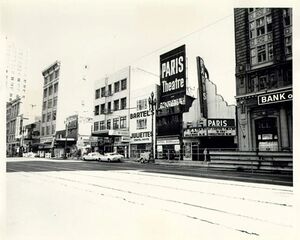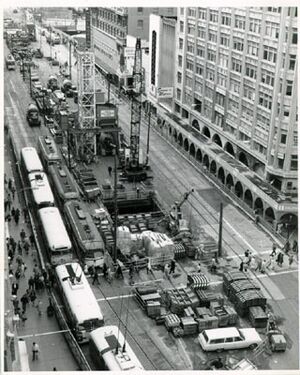Redevelopment Displaces Sex Work Economies
Text by Joey Plaster. Copyright (©) by C. Joey Plaster, 2009. All rights reserved.
These economies would be uprooted and displaced by the late 1960s and early 1970s, as the City worked to convert downtown San Francisco into an administrative and financial headquarters by redeveloping the Market Street and South of Market areas. Construction of Bay Area Rapid Transit (BART), a system meant to funnel workers from the suburbs to downtown offices, tore Market Street up from 1967 to 1972[1], including the Meat Rack and related businesses.
“The Gallencamp’s shoe store (where all the less particular drag’s bought their spikes), the news stand, the Plush Doggie, The Cavalier (with the convenient planter to sit on outside), and Howard’s are scheduled to be demolished,” Guy Strait noted in 1967. “This is the crux of the Meat Market and it will go away.”[2]
But in 1969 the area remained home to “the young outcasts for whom the street has become the shortest route to a meal, a bed, and loose change,” according to one 1969 article. “The less exigent hang themselves on the Rack for a chuckle, for kicks: they spin their earnings into pinball machines of an amusement arcade a few steps away.” The same arcades screened nude films and contained cubicles that hustlers used for rendezvous with clients.[3]
By 1969, the city was engaged in a $34 million beautification of Market Street. “We are going to have a street of excellence, charm, and beauty which us going to attract people from all over the Bay Area and tourists from all over the country,” said Supervisor William C. Blake.[4] The Director of the Market Street Development Project, an association of area businesses, said that “When this becomes one of the great boulevards of the world, it will attract even more undesirables unless something is done soon.”[5]
BART construction was part of a larger conversion of downtown San Francisco into an administrative and financial headquarters. After years of planning, a vast plot of this area was razed and redeveloped as the Yerba Buena Center starting in 1967. As the Redevelopment Agency cleared the land, “those who could afford it moved across Market Street into the Tenderloin District.”[6] Starting in the 1930s, the workingmen’s district in the South of Market area slowly became a “skid row” as the economic basis for their unskilled labor left the city and the residents aged.[7]
In 1966, Glide Minister Ed Hansen noted that Yerba Buena redevelopment would “compound” the problems of the youth who gathered in the Tenderloin. Recent calls for a police cleanup are certainly the least humane things this city and its people can do to stem the waste in young lives,” he wrote. “Yet, Yerba Buena would cause people to move into this area of many unmet needs,” he wrote. “It builds new buildings while it talks of inadequate steps to deal with the pressing human needs.”[8]
“Beautification” of Market Street and redevelopment of the South of Market was accompanied by police sweeps and displacement. “The ‘enemy’ [police] is everywhere, determined to ‘clean up the Tenderloin’ following too many complaints to City Hall,” read a 1968 report from San Francisco’s Night Minister. “Sometimes there are open skirmishes and a paddy-wagon moves in to take another load away. The streets are empty compared to what they once were.”[9]
The Gayzette reported in 1971 that “the ‘meatrack’ was being ‘swept’ unmercifully and without case nor justification” by the San Francisco Police Department’s Tactical Squad.[10] Reverend Ray Broshears, a gay activist who worked closely with the Tenderloin population, reported in 1972 that “the sweeps are being instigated by big business and property owning interests in the downtown area that are looking for the redevelopment of the Tenderloin area.”[11]
By 1974, the Gay Crusader reported, “male hustling is at an all-time low thanks to Lloyd Pluegher of the Downtown Association….Market Street beautification plans include greater police sweeps on that street, which have increased…in the ‘cleaning up’ of Market Street, which is another name for police harassment.” At this time, “money is scarce [in the Tenderloin], the police are hot, the thugs are making hits, merchants are short on cash, stock, and temper [and] drugs are on the increase in use.”[12]
The same year, Don Lucas, San Francisco’s Night Minister, reported:
"The streets have changed….Our city fathers are proud of the ‘clean-up.’ The police brag about a ‘reduction in crime.’ But is this is true, why is there so much fear? Why do more and more people eye me suspiciously? Why are all the streets so barren? Where have all the people gone? The shop-keeper and restaurant owner who complained about people loitering in their doorways had them arrested. And now they are gone. And the shops and restaurants are closed!"[13]
- ↑ Hartman, City for Sale, 9.
- ↑ Citizen’s News, March 1967.
- ↑ “RendezVous for the City’s Outcasts,” San Francisco Chronicle, May 9, 1969.
- ↑ Ibid.
- ↑ San Francisco Chronicle, Nov. 14, 1969, 4.
- ↑ Hartman, City for Sale, 66.
- ↑ Jim Baumohl (Editor), Homelessness in America, (Oryx Press; October 7, 1996), 10.
- ↑ Vector Magazine, Jan 1966, 7.
- ↑ San Francisco Night Ministry records, San Francisco Night Ministry, July/August Sept 1968.
- ↑ “City Within the City,” Gayzette #48, c. 1971.
- ↑ Berkeley Barb, April 7-13, 1972.
- ↑ Gay Crusader, April-May 1974.
- ↑ San Francisco Night Ministry records, 2nd quarter 1974.

